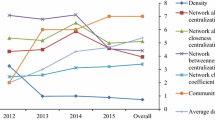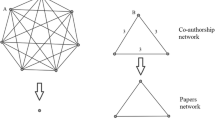Abstract
Objective
This study aims to better understand the dynamics, organisation and collaboration strategies of a research community through social network analysis. While network is particularly adapted to handling the complexity of social interactions between groups, it is currently underused in many research fields. The topology of the social graph and collaboration strategies is rarely investigated or discussed despite its potential usefulness in understanding group dynamics. The author-strategic diagram, based on social network analysis metrics, is proposed and discussed.
Methods
Our analysis considers 10 years of co-authored research publications on privacy. First, we explore the dynamics of the community by analysing the incoming, remaining and departing authors, and the authors’ publishing lifetimes. Second, we focus on the dynamics using social network analysis metrics: distance, modularity, node centralities, local clustering coefficient, assortativity.
Results
Despite the multi-disciplinary nature of privacy research, collaborations exhibit cohesion and a small-world nature. However, the research community is hierarchical, the domain being structured around a few leaders and sub-leaders performing bridging roles between sub-communities. Authors collaborate with others in a similar position in the network except for the leaders, who collaborate a lot, but not with each other. Our author-strategic diagram shows the coexistence of divergent collaboration strategies within a single community related to multiple visions of social capital. Transition phases seem to be present; these could indicate future leaders of the community.
Conclusion
Our results highlight the disparity within the research community and the differing connection types that leaders and other researchers have. Our results show the usefulness of network science in understanding a research field’s community and its dynamics. Comparable analyses of other research communities could help to uncover similar patterns and to tie micro and macro theories together as we show for the theory of social capital.













Similar content being viewed by others
References
ACM digital library. https://www.acm.org (2022). [Online; accessed 25.04.2022].
Alhajj, R., & Rokne, J. (2014). Encyclopedia of Social Network Analysis and Mining. Incorporated: Springer Publishing Company.
Barabasi, A. L., & Posfai, M. (2016). Network science. Cambridge: Cambridge University Press.
Bastian, M., Heymann, S., Jacomy, M. (2009). Gephi: An open source software for exploring and manipulating networks.
Burt, R. (2000). The Network Structure of Social Capital, 22, 345–423.
Burt, R. S. (1992). Structural holes: The social structure of competition. Harvard University Press.
Cavoukian, A. (2009). Privacy by design: The 7 foundational principles.
Chau, M., & Xu, J. J. (2012). Business intelligence in blogs: Understanding consumer interactions and communities. MIS Quarterly, 36(4), 1189–1216.
Clauset, A., Shalizi, C.R., Newman, M.E.J.(2007). Power-law distributions in empirical data. https://doi.org/10.1137/070710111. Cite arxiv:0706.1062Comment: 43 pages, 11 figures, 7 tables, 4 appendices; code available at http://www.santafe.edu/~aaronc/powerlaws/.
Coleman, J. S. (1988). Social capital in the creation of human capital. American Journal of Sociology, 94, S95–S120.
Dinev, T. (2014). Why would we care about privacy? European Journal of Information Systems, 23(2), 97–102. https://doi.org/10.1057/ejis.2014.1.
Dong Noh, J. (2003). Exact scaling properties of a hierarchical network model. Physical Review E, 67, 045103.
Dorogovtsev, S. N., Goltsev, A. V., & Mendes, J. F. F. (2002). Pseudofractal scale-free web. Physical Review E, 65, 066122.
ENISA (2014). Privacy and data protection by design—from policy to engineering. Tech. rep., European Union Agency for Network and Information Security (ENISA).
Erzsebet, R., & Albert-Laszlo, B. (2003). Hierarchical organization in complex networks. Physical Review E, 67, 066122.
EU (2015). Proposal for a Regulation of the European Parliament and of the Council on the protection of individuals with regard to the processing of personal data and on the free movement of such data.
EU (1995). Directive 95/46/EC of the European Parliament and of the Council on the Protection of Individuals with Regard to the Processing of Personal Data and on the Free Movement of Such Data.
Evans, T. S., Lambiotte, R., & Panzarasa, P. (2011). Community structure and patterns of scientific collaboration in Business and Management. Scientometrics, 89(1), 381–396.
Freeman, L. C. (1978). Centrality in social networks conceptual clarification. Social Networks, 1, 215.
Granovetter, M. (1973). The strength of weak ties. The American Journal of Sociology, 78(6), 1360–1380.
Graupensperger, S., Panza, M., & Evans, M. (2019). Network centrality, group density, and strength of social identification in college club sport teams. Group Dynamics. https://doi.org/10.1037/gdn0000106. Publisher Copyright: \(\copyright\) 2019 American Psychological Association.
Haring, M. J. (1998). Research news and comment: Response to “A Woman’s Name: Implications for publication, citation, and tenure’’. Educational Researcher, 27(8), 43–43. https://doi.org/10.3102/0013189X027008043.
Hassan, N. R., & Loebbecke, C. (2017). Engaging scientometrics in information systems. JIT, 32(1), 85–109. https://doi.org/10.1057/jit.2015.29.
Inoue, M., Pham, T., & Shimodaira, H. (2020). Joint estimation of non-parametric transitivity and preferential attachment functions in scientific co-authorship networks. Journal of Informetrics, 14(3), 101042. https://doi.org/10.1016/j.joi.2020.101042.
Khan, G. F. (2013). Social media-based systems: an emerging area of information systems research and practice. Scientometrics, 95(1), 159–180.
Landherr, A., Friedl, B., & Heidemann, J. (2010). A critical review of centrality measures in social networks. Business & Information Systems Engineering, 2(6), 371–385.
Levenshtein, V. I. (1966). Binary codes capable of correcting deletions, insertions and reversals. Soviet Physics Doklady, 10, 707.
Lewison, G., & Markusova, V. (2011). Female researchers in Russia: Have they become more visible? Scientometrics, 89(1), 139–152. https://doi.org/10.1007/s11192-011-0435-5.
Lotka, A. J. (1926). The frequency distribution of scientific productivity, Journal of Architectural and Planning Research, 15.
Lu, Y., Keum, B. T., Chong, E. S., Yeung, J. G., & Kivlighan, D. M., Jr. (2017). Are the ambitions for Group Dynamics: Theory, Research and Practice being fulfilled? A social network analysis of citations of journals publishing group research. Group Dynamics: Theory, Research, and Practice, 21(3), 178.
McLaren, C. D., & Spink, K. S. (2020). Examining the prospective relationship between communication network structure and task cohesion and team performance. Group Dynamics: Theory, Research, and Practice, 24(2), 74.
Moya-Anegon, F., Guerrero-Bote, V. P., Lopez-Illescas, C., & Moed, H. F. (2018). Statistical relationships between corresponding authorship, international co-authorship and citation impact of national research systems. Journal of Informetrics, 12(4), 1251–1262. https://doi.org/10.1016/j.joi.2018.10.004.
Nadeau, D., & Sekine, S. (2007). A survey of named entity recognition and classification. Linguisticae Investigationes, 30(1), 3–26 (Publisher: John Benjamins Publishing Company).
Newman, M. (2003). Fast algorithm for detecting community structure in networks. Physical Review E, 69, 066133.
Page, L., Brin, S., Motwani, R., Winograd, T. (1999). The PageRank Citation Ranking: Bringing Order to the Web. Technical Report 1999-66, Stanford InfoLab. Previous number = SIDL-WP-1999-0120.
Perez, C., Sokolova, K., Dutot, V.(2022). Dataset of privacy related research from 2006 to 2016 extracted from the ACM digital library. https://doi.org/10.7910/DVN/IVJE0D.
Perez, C., Sokolova, K., Dutot, V. (2022). Dataset of privacy researchers from 2006 to 2016 extracted from the ACM digital library. https://doi.org/10.7910/DVN/M8NWEP.
Perez, C., Sokolova, K., Dutot, V. (2022). Network science to uncover strategies and dynamics of the research field. https://graphcommons.com/graphs/972fe5eb-4490-4ba2-b717-7efa845c4cfc.
Price, D. J. d. S. (1963). Little science, big science, New York: Columbia University Press.
Vedres, B., & Stark, D. (2010). Structural folds: Generative disruption in overlapping groups. American Journal of Sociology, 115(4), 1150–1190.
Vidgen, R., Henneberg, S., & Naudé, P. (2007). What sort of community is the European Conference on Information Systems? A social network analysis 1993–2005. European Journal of Information Systems, 16(1), 5–19. https://doi.org/10.1057/palgrave.ejis.3000661.
Watts, D., & Strogatz, S. (1998). Collective dynamics of “small-world" networks. Nature, 393(6684), 440–442. https://doi.org/10.1038/30918.
Wei, F., Zhang, G., Feng, Y., Liu, L., & Shao, Z. (2017). A co-authorship network-based method for understanding the evolution of a research area: A case of information systems research. Malaysian Journal of Library and Information Science, 22(2), 1–14.
Wölfer, R., Faber, N. S., & Hewstone, M. (2015). Social network analysis in the science of groups: Cross-sectional and longitudinal applications for studying intra-and intergroup behavior. Group Dynamics: Theory, Research, and Practice, 19(1), 45.
Wu, Y., Venkatramanan, S., & Chiu, D. M. (2016). Research collaboration and topic trends in Computer Science based on top active authors. PeerJ Computer Science, 2, e41. https://doi.org/10.7717/peerj-cs.41.
Author information
Authors and Affiliations
Corresponding author
Additional information
Publisher's Note
Springer Nature remains neutral with regard to jurisdictional claims in published maps and institutional affiliations.
Rights and permissions
About this article
Cite this article
Perez, C., Sokolova, K. & Dutot, V. Uncovering the Strategies and Dynamics of Research Fields Using Network Science: Structural Evidence from a Decade of Privacy Research. Rev Socionetwork Strat 16, 573–597 (2022). https://doi.org/10.1007/s12626-022-00111-1
Received:
Accepted:
Published:
Issue Date:
DOI: https://doi.org/10.1007/s12626-022-00111-1




